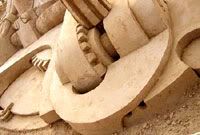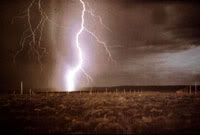- Tag/Categorization Support. I've seen some work-arounds, but it would be much better if it was integrated.
- I'd like to receive e-mail notification if I post a message at someone else's blog and they reply.
My Blogger Wishlist
The Stars My Destination
Gully Foyle is my name
And Terra is my nation
Deep Space is my dwelling place
Death my destination
Gully Foyle has been stranded in deep space on the wreckage of the ship Nomad for 170 days. He has managed to survive by living in the only airtight space left on the ship and scavaging for food and air tanks within the short intervals that his air supply will allow. When a sister ship finally arrives and then abandons Gully to his fate, a murderous rage drives him to affect his own rescue and persue those who have abandoned him.
Thus marks the beginning of The Stars my Destination by Alfred Bester, which flowers into an intriguing tale about a future when humans have colonized the inner planets and several moons of jupiter. I don't want to say anything else about the plot, because I don't want to give any spoilers, but I will say that this is a compelling book that kept me reading at the expense of both food and sleep. Highly recommended.
Also, unusually, this is a book that I would like to see translated to film. I'm not sure if it's been adapted before.
The Ghost Pirates
Lovecraft said of the novel:
"The Ghost Pirates . . . is a powerful account of a doomed and haunted ship on its last voyage, and of the terrible sea-devils (of quasi-human aspect, and perhaps the spirits of bygone buccaneers) that besiege it and finally drag it down to an unknown fate. With its command of maritime knowledge, and its clever selection of hints and incidents suggestive of latent horrors in nature, this book at times reaches enviable peaks of power."
That's a pretty impressive recommendation, and I expected to devour this book, but it was actually a bit slow going for me. I appreciated the precise maritime language, but the atmosphere of subtle, creeping dread never got to me. It was only at the very end of the book that I really became fascinated with the "sea-devils," and of course, that was the climax of the story, and then it was over.
That's not to say that I didn't appreciate Hodgson's idea. I'm generally fascinated by the sea and the presence of ghosts. The presentation of this particular novel just wasn't effective for me.
Legendary Pink Dots
I just noticed that there are Pink Dots MP3s available for download on Epitonic.com which means that my only option is to proselytize.
Specific Recommendations:
Citadel
Spike
Dissonance
Art from Nature
 Kirk Rademaker creates brilliant machines out of sand. They have a definite steampunk aesthetic, and the attention to detail is amazing. It's somewhat sad that these pieces aren't made to last, but that's also a part of their beauty.
Kirk Rademaker creates brilliant machines out of sand. They have a definite steampunk aesthetic, and the attention to detail is amazing. It's somewhat sad that these pieces aren't made to last, but that's also a part of their beauty.I actually came across quite a few other fantastic sand artists, and I may give them a post all to themselves when I have a moment.
 Robert Smithson was an American land artist and a pioneer of the land art movement.
Robert Smithson was an American land artist and a pioneer of the land art movement.Spiral Jetty, which resides at the Great Salt Lake in Utah, is his most famous work. It's 1500 feet long and composed of rocks, earth, salt, and red algae. I think it's absolutely beautiful, and interestingly, it's not always visible because of the fluctuation in the water level.
 Walter De Maria, another land artist, created the Lightning Field in the high desert of New Mexico. It consists of 400 stainless steel poles spaced approximately 220 feet apart.
Walter De Maria, another land artist, created the Lightning Field in the high desert of New Mexico. It consists of 400 stainless steel poles spaced approximately 220 feet apart.Todd Gibson of From the Floor posted an interesting piece about his experience at the Lightning field. Contrary to what I believed, the lightning doesn't actually strike very frequently, but Gibson gives a good idea of what an experience at the lightning field is actually like. It's intriguing.
New Definition of "Planet"
"People love Pluto, children identify with its smallness," she writes. "Adults relate to its inadequacy, its marginal existence as a misfit." Sobel has several solar system models in her house. Asked if she had torn Pluto off any of them, she said "No, Pluto is definitely there."Not being a scientist, I don't have an opinion one way another about whether this particular definition is a good one, but I do have to ask how a child's love of Pluto relates to science?
The House on the Borderland
Two friends take a fishing vacation in a remote part of Ireland, and they stumble across the crumbling ruins of a stone house which has been overtaken by the foliage of a long untended garden. The house sits at the edge of a deep chasm into which flows a river of subterranean origin and also, as we soon find out, acts as a door to another dimension.
Within the rubble, the two men find the journal of an old man who once lived in the house, and they take the journal back to their campsite for further perusal. The tale that resides inside of that age-worn book is a masterpiece of the weird.
Imagine watching billions of years pass before your eyes in a matter of days, and you'll get the vaguest sense of the apocalyptic imagery that exists within this book. It's both haunting and surreal, and the story even features a chilling cameo by that darling of India, Kali the destroyer.
The only thing that I didn't care for is the inclusion of the ethereal love interest, and that's mostly because it was terribly underdeveloped. The reader gets a better sense of the relationship between the main character and the dog, Pepper (who I really liked). Had Hodgson left the romance bit out, this book would have been nearly perfect.
An online version of the text can be found at Project Gutenberg.
The Boats of the Glen Carrig
The Boats of the Glen Carrig is the story of a ship lost at sea and the strange adventures that befall the crew after they escape in two lifeboats and make their way into a wild Sargasso sea filled with dead ships and a plethora of monsters, some real and some otherworldly.
It's a page turner, and while there are some melodramatic bits, Hodgson is a master at creating an atmosphere of subtle, creeping dread. Highly recommended, especially if you like a good, imaginative yarn of the sea.
iPAQ 5455
 My husband brought me home an iPAQ 5455 which is very exciting for me as I read many books in e-format, particularly those in the public domain. I get them from sites like Project Gutenberg and The Literary Gothic. I also used to get them from Black Mask, but it's been missing in action, and I'm hoping for its eventual return.
My husband brought me home an iPAQ 5455 which is very exciting for me as I read many books in e-format, particularly those in the public domain. I get them from sites like Project Gutenberg and The Literary Gothic. I also used to get them from Black Mask, but it's been missing in action, and I'm hoping for its eventual return.Prior to receiving this lovely new toy, I was using a monochrome, handspring visor (cobalt blue), which worked wonderfully for me. It had some limitations due to its age and operating system. For example, I didn't have the ability to read microsoft reader files and the graphic capabilities were unimpressive to say the least, but I was able to read many amazing books on it, and it had the ability to take a large amount of abuse. I periodically fall asleep during late night reading sessions and drop my handheld computer on the floor which never seemed to phase it. This machine seems to be a bit more fragile, and I'll have to take greater care with it, but I'm really excited about the prospect of color, the ability to play music, and internet connectivity!
I know many people who just can't fathom the idea of reading a book on a computer screen. It lacks the tangibility and the romanticism of paper, but there are advantages as well. Reading in the dark without having to worry about waking anyone up is great, and I like to be able to store many different books and take them with me. It works well for rapidly changing moods.
Of course, there are some books that I still feel the need to own in a more tangible form, and I don't think I'll ever get over that, but there's something to be said for paperless communication.
The Glass Armonica
 About a month ago my husband and I watched Mesmer and became completely infatuated with a musical instrument that appeared in the film. It was composed of nested cylinders of glass which were rotated on a spindle, and at the touch of human hands, vibrated in much the same way that a wine glass vibrates when you run a wet finger along the rim.
About a month ago my husband and I watched Mesmer and became completely infatuated with a musical instrument that appeared in the film. It was composed of nested cylinders of glass which were rotated on a spindle, and at the touch of human hands, vibrated in much the same way that a wine glass vibrates when you run a wet finger along the rim.
At the time, we didn't realize that this instrument is called the Glass Armonica, and it was invented by Ben Franklin in 1761. He had heard another artist playing the wine glasses, and he decided that he could devise an instrument that would have the same qualities but with greater functionality.
The instrument became very popular in its day, and it's history is nearly as interesting as the sound that it creates. Several artists, including Mozart and Beethoven, composed pieces for the Glass Armonica, and Marie Antoinette took Armonica lessons, however, the instrument began to lose its popularity when rumours began to spread inferring that the instrument was a cause of insanity.
According to the German musicologist, Friedrich Rochlitz:
There may be various reasons for the scarcity of armonica players, principally the almost universally shared opinion that playing it is damaging to the health, that it excessively stimulates the nerves, plunges the player into a nagging depression and hence into a dark and melancholy mood, that it is an apt method for slow self-annihilation… Many (physicians with whom I have discussed this matter) say the sharp penetrating tone runs like a spark through the entire nervous system, forcibly shaking it up and causing nervous disorders.
As these types of rumours continued to spread, the popularity of the instrument waned, but it's still possible to purchase one, and there are still composers such as William Zeitler who claim the Glass Armonica as their primary instrument. I definitely recommend checking out Mr. Zeitler's site, as it's filled with interesting historical information about the instrument.
Also, if you'd like to hear the glass armonica, there's an article at PBS.org that has a soundclip.
There's also an interactive “virtual armonica” that you can play.
Thank you to hardrockzombie in the darkvictoria community for shedding some light on this enigmatic instrument! This is the kind of thing that I adore.
Gothic Americana
"Whether it is called Gothic country, American Gothic or Gothic folk, the sound is dark, plainspoken and often morose. Sometimes it's morbid, yet it's also often uplifting - and always thoughtful."
My personal favourites are Munly and the Lee Lewis Harlots, Woven Hand, and Sixteen Horsepower which make frequent rounds in my CD player, but the others a worth a listen as well.
Munly and the Lee Lewis Harlots
Woven Hand
Sixteen Horsepower
Lilium
Denver Broncos
Slim Cessna's Auto Club
Tarantella
Denver Gentlemen
DeVotchka
Urban Exploration
At the time, I was unaware of some of the brilliant, urban exploration artists that are out there documenting these places that most of us will never see. Slowly, but surely, I'm seeking them out on the web, so that I can live vicariously through their work. Here are a couple of links that I like.
Rana X - Sexy, derelict buildings with the occasional beautiful girl.
Mello Photography - Check out the power plant shots. Nice.
Sleepy City - Dsankt takes beautiful, mad photographs.
Infiltration - An urbex webzine with a lot of great links to urban explorers all over the world. This is probably the best resource that I've found.
Abandoned Places - The LJ community where I discovered Rana X and Bill Mello. Definitely worth checking frequently, as there are a lot of talented artists that post on a daily basis.
Dusting off the Cobwebs
This blogger account has been in my possession for quite a while, and I think it's time to dust off the cobwebs.




